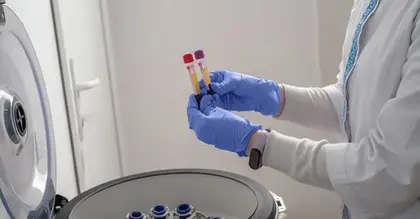
New research investigates why men tend to develop diabetes at lower BMIs and younger ages than women. Image credit: Halfpoint/Getty Images.
- Men and women have different fat distribution, and doctors already know that this can affect men’s risk of cardiovascular disease and type 2 diabetes.
- Men tend to develop type 2 diabetes earlier and at a lower BMI than women.
- Researchers from Karolinska Institutet in Stockholm, Sweden have shown that abdominal fat in obese men with type 2 diabetes has higher insulin resistance and different levels of gene expression than women.
- Another set of researchers from Australia have shown that men are more likely to develop type 1 and type 2 diabetes-related complications than women.
Men with type 2 diabetes and obesity exhibit a higher level of insulin resistance in their adipose tissue than women.
This sex difference in people with type 2 diabetes was observed by scientists from the Karolinska Institutet in Stockholm, Sweden.
Researchers discovered that this higher level of insulin resistance in men was due to a less efficient inhibition of fat cell lipolysis, the process of metabolizing fat.
Evidence suggests that the breakdown of fat cells by lipolysis leads to raised levels of
First author Daniel Andersson, PhD, MD, consultant cardiologist and assistant professor at Karolinska Institutet, told Medical News Today:
“Our research group has been interested in studying different aspects of insulin resistance in adipose tissue for several years. It is well known that there are sex differences between men and women and the risk of getting type 2 diabetes. However, the underlying mechanisms for the sex difference in risk and the impact of local insulin resistance in adipose tissue is not fully understood.”
The results of this study first appeared in the
People with type 2 diabetes were recruited to the study from the Stockholm area between 1993 to 2020 for a range of studies on metabolism.
For this part of the study, 2,344 women and 787 men were recruited, who self-reported stable weight for 3 months. They were invited to attend a clinic at 8 a.m., after overnight fasting.
Data was also collected on their BMI, age, physical activity, cardiometabolic disease and tobacco use. Researchers performed a blood test that measured circulating levels of fatty acids and insulin in male and female participants, and adjusted this for BMI, physical activity, cardiometabolic disease and tobacco use.
A subset of a subset of 259 female and 54 male participants also had subcutaneous fat samples taken from their abdominal area.
The blood test, called
These sex differences occurred regardless of the level of physical activity, the presence of cardiometabolic disease, or nicotine use.
The researchers discovered that there were differences in the levels of lipolysis and lipogenesis (fat production), and cells’ sensitivity to them, between men and women with obesity, but not in those without obesity.
In fact, the adipose tissue of women with obesity exhibited 10 times higher insulin sensitivity than men. Fat cells taken from men with obesity exhibited twice the rate of lipolysis than women.
The genetic expression of a second group was also investigated, with a group of 115 men and 234 women with obesity included in the study.
Researchers looked at the mRNA expressed in the fat cells to determine which genes were being expressed. They discovered that the gene encoding insulin receptor substrate 1 IRS1 was expressed less in men than in women.
Further analysis showed that there were differences in the expression of certain genes, including testosterone receptors in male fat tissue, compared to fat tissue taken from women.
The study authors propose that the sex differences seen are due to the different hormone profiles of men and women affecting the metabolic pathways in the adipose tissue.
Alexandra Kautzky-Willer, MD, from the Medical University of Vienna, specialist in endocrinology and gender medicine, not involved in this studies, told MNT that “[w]e know that women have to put on more weight to develop diabetes,” which means that they often have a higher BMI than men at the time of diagnosis, and that is why they exhibit similar insulin resistance to men at that point.
Another study published recently in the Journal of Epidemiological Community Health showed that men were at greater risk of developing complications related to type 1 and type 2 diabetes than women, irrespective of how long they had the condition.
Analysis of a cohort of 25,713 men and women over the age of 45 based in Australia showed that men were at a 51% increased risk of cardiovascular disease compared to women, a 47% increased risk of lower limb complications, 55% increased risk of kidney complications and 14% increased risk of diabetic retinopathy.
If there are sex differences when it comes to insulin resistance and to the risk of major complications associated with diabetes, the question arises: Should men and women also follow different treatment pathways?
“Drugs that reduce weight are preferred for all patients with type 2 diabetes but especially for women,” said Kautzky-Willer. She explained to MNT that some different
“During puberty women are more insulin resistant, but thereafter more insulin sensitive than men until menopause; and better insulin response and better lipid profile (lower LDL cholesterol) and lower blood pressure. They have better fat storage (energy reserve for possible pregnancies); however, after menopause, women lose their biological advantage and develop the androgen phenotype,” she detailed.
The authors of the first study propose that their findings suggest that insulin resistance in men with obesity could be specifically targeted with pharmaceutical and lifestyle interventions to prevent type 2 diabetes, but that their findings need to be backed up with prospective studies.
The reasons for the differences in fat distribution and behavior needed to be further investigated, said Kautzky-Willer.
“We need to investigate sex and gender differences in therapies and interventions. Most studies are underpowered to give valuable insights and in most studies women are only 30% [of the cohort],“ she pointed out.
“However, in obesity studies there are usually much more women (70%), and thus even in some obesity randomized control trials we have approximately 50% women,“ she further suggested. “So we have the chance to explore sex differences in pathophysiology and response to treatments.“
To do improve diabetes research, Kautzky-Willer argued:
“[I]t will be necessary to measure more than just weight reduction as an outcome! We need to explore the changes in body fat distribution and lean mass (muscle!), and study changes in intraorgan fat deposits — [fat deposits inside organs, such as the] pancreas, heart etc. Then we could be able to detect new targets and start real precision therapy in men and women.”
Around 95% of the cohort of the first study were of white European origin, so it is not possible to extrapolate its findings to people of different ancestries, despite people of African and Asian ancestry being more likely to develop type 2 diabetes. Another step forward, therefore, should also be to diversify participant cohorts in studies on diabetes.





